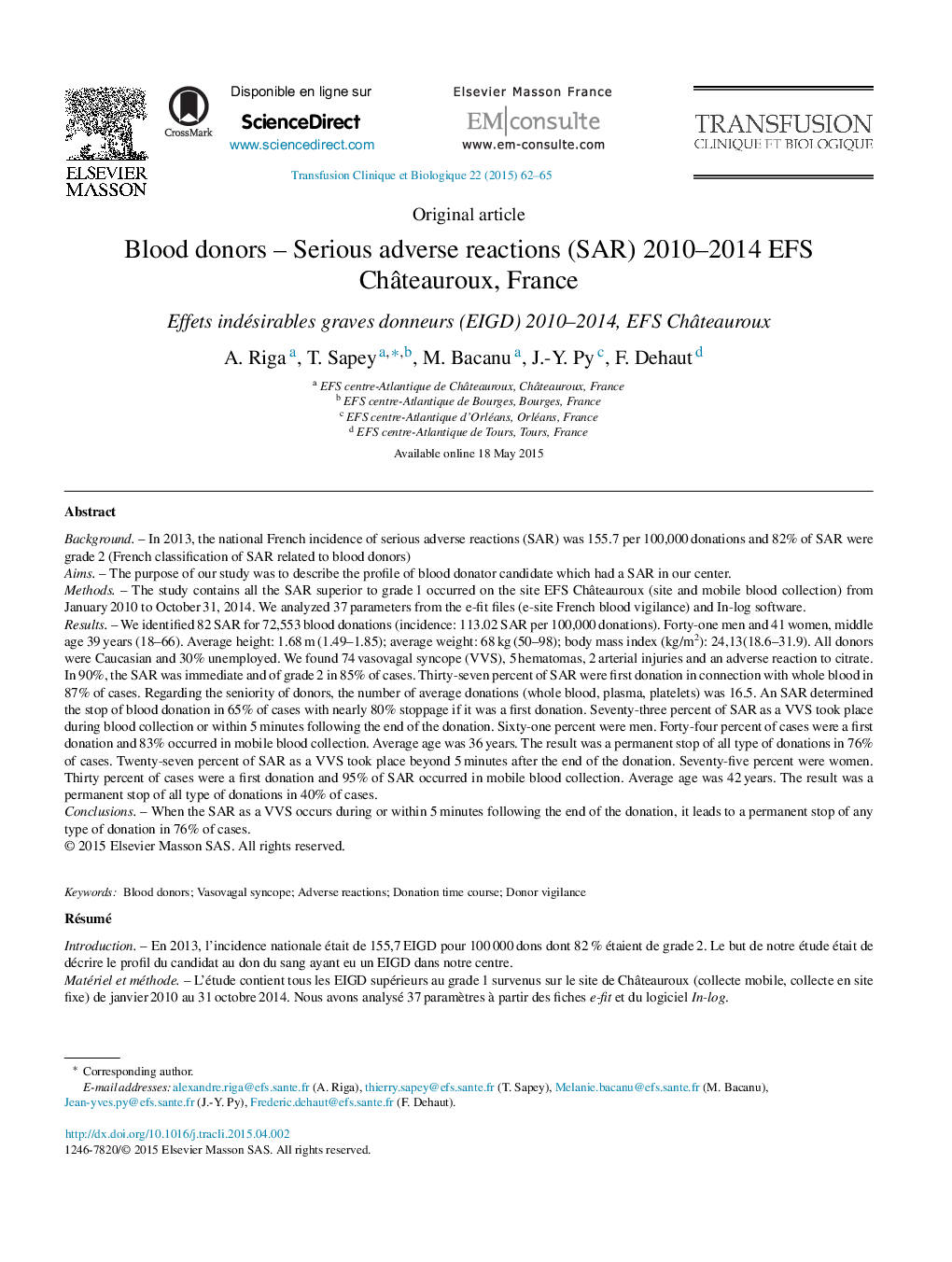| کد مقاله | کد نشریه | سال انتشار | مقاله انگلیسی | نسخه تمام متن |
|---|---|---|---|---|
| 1104982 | 954172 | 2015 | 4 صفحه PDF | دانلود رایگان |
BackgroundIn 2013, the national French incidence of serious adverse reactions (SAR) was 155.7 per 100,000 donations and 82% of SAR were grade 2 (French classification of SAR related to blood donors)AimsThe purpose of our study was to describe the profile of blood donator candidate which had a SAR in our center.MethodsThe study contains all the SAR superior to grade 1 occurred on the site EFS Châteauroux (site and mobile blood collection) from January 2010 to October 31, 2014. We analyzed 37 parameters from the e-fit files (e-site French blood vigilance) and In-log software.ResultsWe identified 82 SAR for 72,553 blood donations (incidence: 113.02 SAR per 100,000 donations). Forty-one men and 41 women, middle age 39 years (18–66). Average height: 1.68 m (1.49–1.85); average weight: 68 kg (50–98); body mass index (kg/m2): 24,13(18.6–31.9). All donors were Caucasian and 30% unemployed. We found 74 vasovagal syncope (VVS), 5 hematomas, 2 arterial injuries and an adverse reaction to citrate. In 90%, the SAR was immediate and of grade 2 in 85% of cases. Thirty-seven percent of SAR were first donation in connection with whole blood in 87% of cases. Regarding the seniority of donors, the number of average donations (whole blood, plasma, platelets) was 16.5. An SAR determined the stop of blood donation in 65% of cases with nearly 80% stoppage if it was a first donation. Seventy-three percent of SAR as a VVS took place during blood collection or within 5 minutes following the end of the donation. Sixty-one percent were men. Forty-four percent of cases were a first donation and 83% occurred in mobile blood collection. Average age was 36 years. The result was a permanent stop of all type of donations in 76% of cases. Twenty-seven percent of SAR as a VVS took place beyond 5 minutes after the end of the donation. Seventy-five percent were women. Thirty percent of cases were a first donation and 95% of SAR occurred in mobile blood collection. Average age was 42 years. The result was a permanent stop of all type of donations in 40% of cases.ConclusionsWhen the SAR as a VVS occurs during or within 5 minutes following the end of the donation, it leads to a permanent stop of any type of donation in 76% of cases.
RésuméIntroductionEn 2013, l’incidence nationale était de 155,7 EIGD pour 100 000 dons dont 82 % étaient de grade 2. Le but de notre étude était de décrire le profil du candidat au don du sang ayant eu un EIGD dans notre centre.Matériel et méthodeL’étude contient tous les EIGD supérieurs au grade 1 survenus sur le site de Châteauroux (collecte mobile, collecte en site fixe) de janvier 2010 au 31 octobre 2014. Nous avons analysé 37 paramètres à partir des fiches e-fit et du logiciel In-log.RésultatsNous avons recensés 82 EIGD pour 72 553 dons (incidence de 113,02 EIGD pour 100 000 dons). Quarante et un hommes et 41 femmes, d’âge moyen : 39 ans (18–66). Nous avons trouvé 74 malaises vagaux, 5 hématomes, 2 blessures artérielles et une réaction au citrate. Dans 90 %, l’EIGD était immédiat et de grade 2 dans 85 % des cas. Dans 37 % des cas, il s’agissait d’un premier don, en rapport avec du sang total dans 87 %. L’apparition d’un EIGD entraînait un arrêt définitif de tout don dans 65 % des cas avec près de 80 % s’il s’agissait d’un premier don. Soixante-treize pour cent des EIGD sous la forme d’un malaise vagal avaient lieu pendant le prélèvement ou dans les 5 minutes qui suivaient son arrêt. Soixante et un pour cent étaient des hommes. Dans 44 %, il s’agissait d’un premier don. Cela entraînait un arrêt définitif de tout don dans 76 %. Vingt-sept pour cent des EIGD sous la forme d’un malaise vagal avaient lieu au-delà de 5 min après la fin du prélèvement. Soixante-quinze pour cent étaient des femmes. Dans 30 %, il s’agissait d’un premier don. Cela entraînait un arrêt définitif de tout don dans 30 %.ConclusionLorsque l’EIGD sous la forme d’un malaise vagal se produit pendant le prélèvement ou dans les 5 minutes qui suivent son arrêt, il entraîne un arrêt définitif de tout don dans 76 % des cas.
Journal: Transfusion Clinique et Biologique - Volume 22, Issue 2, June 2015, Pages 62–65
